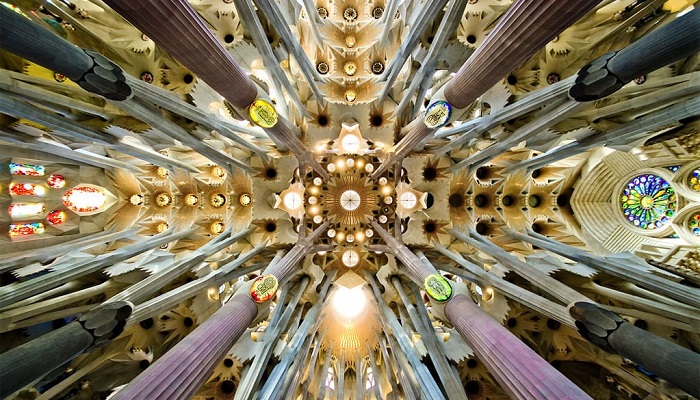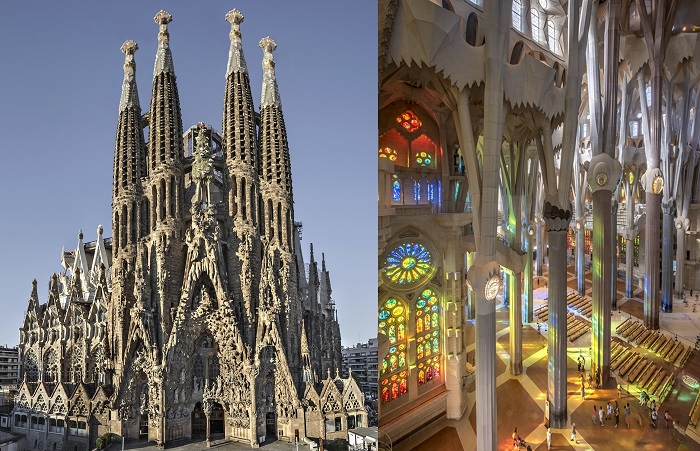ISABEL RUBIO ARROYO | Tungsteno
The Sagrada Familia is not only the tallest modernist church in the world designed in the art-nouveau style, according to the Guinness Book of Records, but also the most beautiful building on the planet, as determined by the travel website TripAdvisor, based on the opinions of its users in more than 130 countries. We analyse the secrets of this unique structure, whose construction has overcome numerous obstacles and was heavily inspired by nature.
Although the original design of the Sagrada Familia was based on the outlines of medieval cathedrals, the architect Antoni Gaudí i Cornet modernised the construction techniques as well as their function and symbolism. As the architect Norman Foster says, "Gaudí's methods, one century later, are still revolutionary." In a context where many architects favoured achromatic spaces with straight lines, he opted for a multitude of colours and curved forms.
Over 50 different types of stone weighing 200,000 tonnes
The cornerstone of the Sagrada Familia was laid on 19 March 1882. Fifty different types of stone have been used so far in the construction of this mega-structure, which weighs more than 200,000 tonnes. Among the materials Gaudí used was reinforced concrete, which allowed him to create complex, organic forms and made the building more durable and resistant to possible earthquakes. This would not have been possible with other traditional building materials.
Sandstone from the Montjuïc mountain in Barcelona has also been used. "Due to the very limited availability of this stone (the quarries have been closed for years and the only stone available comes from old buildings in Barcelona that are torn down), different types of stone have been used for the windows and part of the towers, such as granite and other sorts of sandstone," explains the monument's official website.
Every detail is important in the process. When a block of stone leaves the quarry, a sample is taken to analyse its quality, according to the Sagrada Familia blog. This is a crucial factor in deciding which part of the temple it will be used to build. About 80 kilometres from Barcelona, there is a materials depot where these tests are carried out and the pieces of the temple are manufactured. The aim is that the assembly of the pieces at the Sagrada Familia site take as little time as possible, thereby reducing the potential risks of constructing while the temple is open to the public.

More than 50 types of stone have been used to build the Sagrada Familia. Credit: Mikipons / Wikimedia Commons
Spiral staircases and other influences from nature
The Sagrada Familia is strongly inspired by nature. In Gaudí's own words: "The great book, always open and which we should make an effort to read, is that of Nature, and the other books have been derived from it, and in them are to be found the errors and misinterpretations of men." According to the Cervantes Institute, the architect looked at how nature "overcomes gravity and what forms are the most resistant; what is the shape of a cave, a mountain, the shores of a lake, termite mounds, anthills, the lairs created by animals that, like man, live in societies..."
Spiral staircases are an example clearly related to nature, but not the only one. For Gaudí, an inclined column was more stable than a vertical one. For this reason, in the naves he proposed a structure based on inclined columns that branch out from the double-twist column like the branches of a tree. "In this way, they manage to define a space that is reminiscent of a forest and that, by virtue of its characteristics, invites introspection and prayer," according to the temple’s official website.
Nature inspired Gaudí when it came to building the Sagrada Familia. Credit: Time
A civil war and other obstacles to construction
This structure is undoubtedly Gaudí's most emblematic creation. The leading exponent of Catalan Modernism, who succeeded Francisco de Paula del Villar y Lozano, Gaudí devoted himself exclusively to the church from 1914 until his death in 1926. He himself was aware that he would not be able to complete a structure of such size and complexity, and that later generations would have to bring it to fruition.
The construction of the Sagrada Familia has required the involvement of several generations of architects. Credit: Interesting Engineering
The construction of the Sagrada Familia, which is still ongoing, has not been without its obstacles. In 1936, for example, it was the target of vandalism during the Spanish Civil War. Plans, photographs and plaster models were destroyed and work was interrupted until the 1950s. Although work on the Sagrada Familia was due to be completed by 2026 —the centenary of Gaudí's death—it was delayed by the coronavirus pandemic. It is now expected that the highest tower of the temple, the Jesus Tower, will be completed that year. Although the completion date of the work is still unknown, one thing is clear: it is getting closer and closer.
· — —
Tungsteno is a journalism laboratory to scan the essence of innovation.
